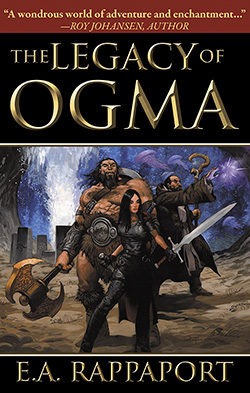Review by Monique Howard

In The Legacy of Ogma by E.A. Rappaport, Halia, a young thief unearths a mystical crystal sphere; she becomes entangled in a life-altering journey. Along her adventures, Halia encounters sorcerers, warriors and demonic beasts, as she endeavors to find answers pertaining to a legendary treasure. I found the author's concepts to be quite inventive. Using a physical element to transport the characters` into another universe was a worthy endeavor.
The Legacy of Ogma is a fine sample of classic fantasy. The genre's traditional roles of chivalrous warriors, street-smart orphans and ambitious apprentices are all in good form. The novel's solid character development allows Halia to be more than a mere thief. The character rises beyond her life station. The novel's female protagonist is a well-balanced character. Halia `s thirst for treasure does not allow her to abandon all moral principles. Being a thief does not brand her as an emotionally cold character, which is immune to justice, compassion and generosity. She looks after her fellow companions and is willing to fight beside them.
The common flaw in a multi-layered plot with numerous characters is a lack of distinction amongst the characters and emotional ties to the audience. Often, their characters assume a stereotypical role and become plot devices instead of multi-dimensional beings. This is not the case in the The Legacy of Ogma. The challenge of developing a compelling story with engaging characters is nicely handled. Arwold is not the genre's standard warrior. His startling sense of chivalry is akin to an Arthurian knight. His views of justice rise beyond what is expected for such a role.
In this genre, authors typically offer a single elaborate concept or multiple creative concepts, which slow the story's pace and clutter the plot's functional pathways. A plot with a single major concept is often slow when coming full circle. The reader may lose interest before reaching the middle of the story. A fantasy novel with numerous concepts offers the reader too many creative elements; and the story is so laden with whimsy that the plot and character motivation can be lost in the process. However, in this novel, E.A. Rappaport finds a healthy balance. He offers magical elements, which enhance the plot instead of distracting or boring the reader.

